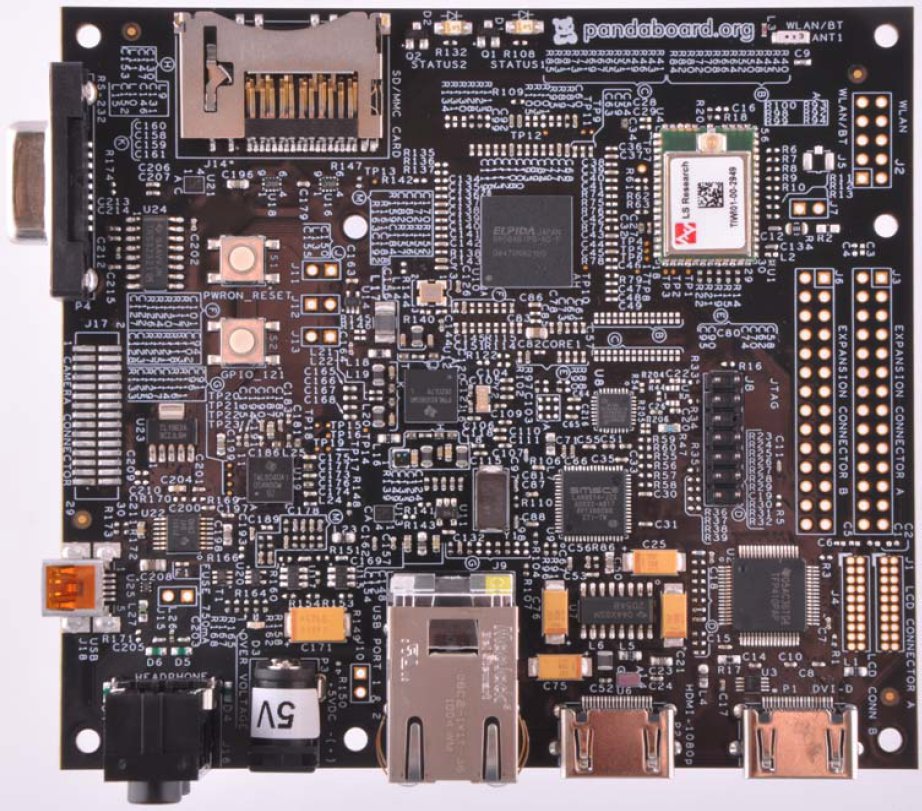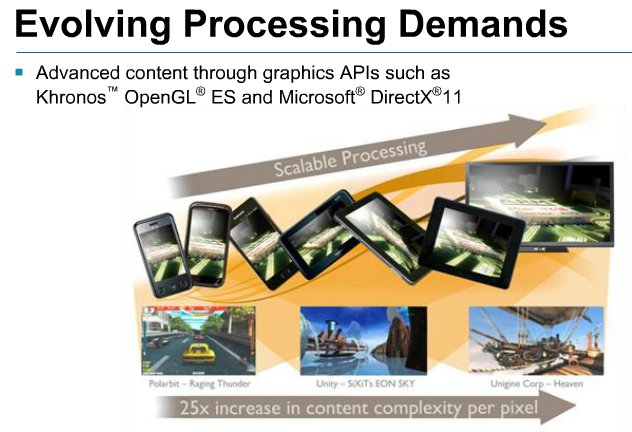Somehow I’ve missed the announcement of the Pandaboard ES – a new version of the Pandaboard low cost development board – last month. The Pandaboard ES is built around OMAP4460 processor running at 1.2 GHz with 1GB RAM and an SD/MMC card slot. It features onboard 10/100MBit Ethernet, Wifi, Bluetooth, several video output ports (HDMI, DVI-D, LCD Expansion and DSI), audio input/audio, several expansion ports (USB 2.0 OTG, USB 2.0 host, GPIO header, camera header..) and debug ports (JTAG, UART, 2 status LEDs, 1 GPIO button and sysboot switch). It has the same form factor as the original Pandaboard (114.3mm x 101.6mm) and weights 81.5g instead of 74g for the Pandaboard. The cost is however slightly higher at 182 USD (recommended price) vs. 174 USD for the Pandaboard. To help you choose which board is best for you, I’ve created a table comparing Pandaboard and Pandaboard ES specifications and features. […]
Android 4.0 Demo on Ziilabs Jaguar Tablet Reference Design
Yet another Android 4.0 demo on a development platform. This time, Android 4.0.1 runs on a Jaguar Tablet powered by Ziilabs ZMS-20 ARM Cortex A9 processor. It runs pretty smoothly. Jean-Luc Aufranc (CNXSoft)Jean-Luc started CNX Software in 2010 as a part-time endeavor, before quitting his job as a software engineering manager, and starting to write daily news, and reviews full time later in 2011. www.cnx-software.com
World’s First Android 4.0 Tablet is based on Rockchip RK2918
Rockchip has announced Android 4.0.1 (ICS) would be ready by the first week of December with Rochchip RK2918 based tablets shipping with the new OS available later in December. The company claims this will be the first Android 4.0 tablet available in the market. That also means that owners of Archos Arnova G2 tablets should be able to run Android 4.0 very soon. The demo below seems relatively smooth compared to other demos I have seen on development boards such as ST Ericsson Snowball, so I suppose Rockchip has already enabled hardware acceleration. Jean-Luc Aufranc (CNXSoft)Jean-Luc started CNX Software in 2010 as a part-time endeavor, before quitting his job as a software engineering manager, and starting to write daily news, and reviews full time later in 2011. www.cnx-software.com
Linaro 11.11 Release with Kernel 3.1.1 and Android 4.0.1 Support
Linaro has just released version 11.11 based on Linux Kernel 3.1.1 and with support for Android ICS. The Android 4.0.1 Preview build for all low cost development boards supported by Linaro are available at http://releases.linaro.org/11.11/android/images-ics-preview/. Here are the highlights of the release: Android Linaro’s baseline has now been upgraded to 2.3.7. The first Versatile Express Android build has been completed. Pandaboard and Vexpress has been upgraded to kernel 3.1.1. A preview of Ice Cream Sandwich is released and running on Snowball, Origen, iMX53 and on Pandaboard with Linaro kernels. A NEON-optimized libpng has been itegrated in all builds. Preliminary DS-5 support has been integrated. Preliminary WiFi support on Android Origen. Kernel config for each build is available on android-build page. USB Ethernet works on Origen. Camera recording function works on Pandaboard. USB camera can be hotplugged on Pandaboard. Developer Platform Firefox can now be cross-built using multiarch. Instructions are available […]
Android 4.0 on ST Ericsson Snowball Development Board
Android 4.0.1 can now run on ST Ericsson Nova A9500 low cost development board “snowball”. The build is available at https://android-build.linaro.org/builds/~linaro-android/staging-snowball/. You can Android 4 (ICS) it in action in the Snowball board in the video build using build number 84. This is a bit sluggish since Android 4 currently lacks hardware acceleration on this development board but Linaro and the igloocommunity will implement it in the next few weeks. If you have an ST Ericsson snowball board, here are the instructions to try the latest Android 4.0 build for the platform: Get the images: wget –no-check-certificate https://android-build.linaro.org/jenkins/job/linaro-android_staging-snowball/lastSuccessfulBuild/artifact/build/out/target/product/snowball/boot.tar.bz2 wget –no-check-certificate https://android-build.linaro.org/jenkins/job/linaro-android_staging-snowball/lastSuccessfulBuild/artifact/build/out/target/product/snowball/system.tar.bz2 wget –no-check-certificate https://android-build.linaro.org/jenkins/job/linaro-android_staging-snowball/lastSuccessfulBuild/artifact/build/out/target/product/snowball/userdata.tar.bz2 Get the linaro-image-tools and create the image: bzr branch lp:linaro-image-tools ./linaro-image-tools/linaro-android-media-create –mmc /dev/sdc –dev snowball_sd –system system.tar.bz2 –userdata userdata.tar.bz2 –boot boot.tar.bz2 MINICOM settings: minicom -D /dev/ttyUSB0 -w -C minicom.txt You must setup the boot args as follows: U8500 $ setenv loadbootscript fat load mmc 1:1 ${loadaddr} […]
Android 4.0 on BeagleBoard and Beagleboard-xM
Sola has written the instructions (in Japanese) to build Android 4.0 (ICS) for Beagleboard and Beagleboard-xM. Here’s the same in English: Get the source code: $ mkdir -p /home/sola/work/ics $ cd /home/sola/work/ics $ export ANDROID_ROOT=$PWD $ repo init -u https://bitbucket.org/sola/android_manifest $ repo sync -j8 Build Android: $ cd $ANDROID_ROOT $ source build/envsetup.sh $ lunch full_beagleboard_xm-eng [for BeagleBoard-xM] $ lunch full_beagleboard-eng [for BeagleBoard] $ time make -j8 Generate the rootfs: $ cd $ANDROID_ROOT/out/target/product/beagleboard_xm/ [for BeagleBoard-xM] $ cd $ANDROID_ROOT/out/target/product/beagleboard/ [for BeagleBoard] $ mkdir rootfs $ sudo cp -a ./root/* ./rootfs/ $ sudo cp -a ./system/* ./rootfs/system/ Build the kernel: $ export ARCH=arm $ export CROSS_COMPILE=$ANDROID_ROOT/prebuilt/linux-x86/toolchain/arm-eabi-4.4.3/bin/arm-eabi- $ cd $ANDROID_ROOT/board/beagleboard/kernel $ make omap3_beagle_android_defconfig $ make uImage modules -j8 Partition the SD card (bootloader, media, rootfs): $ cd $ANDROID_ROOT/board/beagleboard/sdcard $ sudo LANG=C ./mksdcard_beagle.sh /dev/sdx where /dev/sdx depends on your setup (e.g. /dev/sda). Generate boot.scr: $ cd $ANDROID_ROOT/board/beagleboard/bootscript $ ./mkbootscr Copy MLO/u-boot.bin/uImage/rootfs to the SD card: […]
CIFS/Samba Support, USB Drive and Keyboard/Mouse for Android 4.0
Paul O’Brien, founder of modaco, has created a custom kernel with CIFS/SAMBA support, USB drive and keyboard / mouse support for Galaxy Nexus smartphone running Android 4.0 (ICS). This is a temporary download until MCR (MoDaCo Custom ROM) is released. This should be flashed via ‘fastboot flash boot boot.mck.img’ to a device with an unlocked bootloader. This is designed for devices running the I9250XXKK1 / ITL41D (android-4.0.1_r1) ROM. DOWNLOAD – MD5: adf6bcc42205027952630dcf720beada Source: http://android.modaco.com/topic/348882-23-nov-modaco-custom-kernel-cifs-usb-drives-keyboard-mouse/ Jean-Luc Aufranc (CNXSoft)Jean-Luc started CNX Software in 2010 as a part-time endeavor, before quitting his job as a software engineering manager, and starting to write daily news, and reviews full time later in 2011. www.cnx-software.com
Midgard architecture for Embedded GPUs (Mali-T604 / Mali T658)
I’ve attended a webinar entitled “Harness the power and flexibility of the Midgard architecture for Embedded GPUs” presented Steve Steele, Product Manager at ARM Media Processing Division and sponsored by EETimes. Steve starts to talk about the current GPU architecture “Utgard” used in Mali-200, Mali-300 and Mali-400MP which allows resolutions up to 1080p and are used in many smartphones today including Samsung Galaxy S2 (Mali-400MP) which provides great graphics performance. He then explains how mobile devices are used today and what performance we may except in the future: Mobile As Main compute platform: New UI and Augmented Reality Social Networks and emails Content Creation/consumption 1 Device to multiple screen (e.g LCD screen and TV via HDMI) Evolving Processing Demand: Graphics Complexity multiplied by 25 Increase in screen size (1080p resolution support). Graphics API: Khronos OpenGL ES, Microsoft DirectX 11 Compute API: OpenCL, Renderscript Compute and Direct Compute. After this overview, […]





